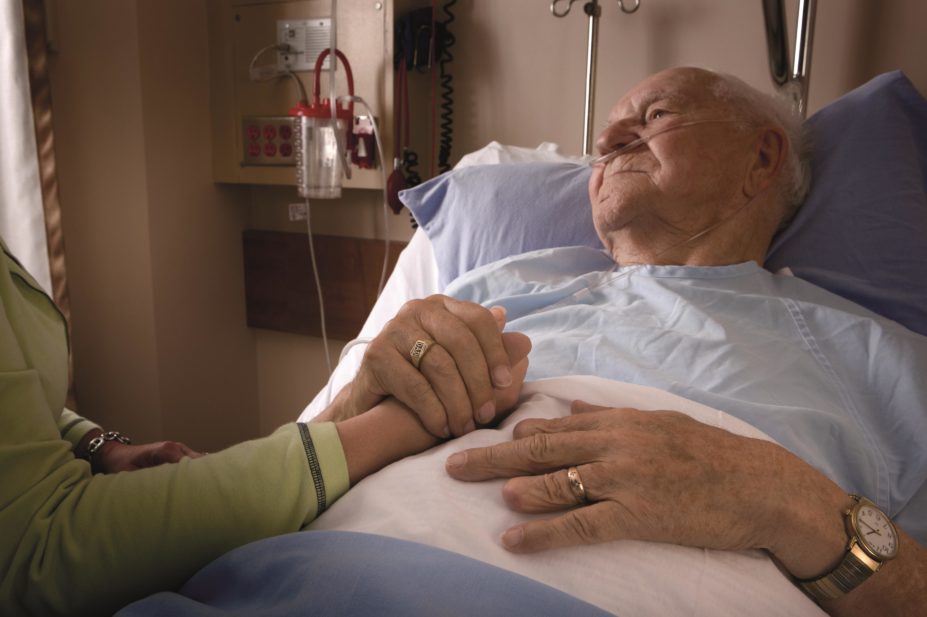
Design Pics Inc / Rex Features
In this article you will learn:
- Why the Liverpool Care Pathway was replaced
- The new priorities for care of dying patients
- Key areas where pharmacists can help improve palliative care
More than 500,000 people die in England each year. Most people die in a hospital (58%), while 18% die at home, 17% die in a care home, and 4% in a hospice[1]
. The Liverpool Care Pathway (LCP) for dying patients was developed by the Marie Curie Hospice and the Royal Liverpool University Hospital to improve the care of dying patients in a hospital setting, based on the widely held belief among carers and relatives that the end of life care delivered in hospices is better than that in hospitals.
However, in June 2013, the Department of Health decided to phase out the LCP following an independent review, More Care, Less Pathway, chaired by Baroness Neuberger[2]
. The use of the LCP in the NHS stopped from 1 July 2014 and has been superseded by individual care plans.
The demise of the LCP was surrounded by controversy. The intention is for individual care plans to bring a high level of care, communication and understanding for dying patients and their families.
What was the Liverpool Care Pathway?
The LCP was originally developed to care for terminally ill patients with cancer in an acute hospital setting. It was then successfully adapted for patients with other terminal conditions, such as heart failure and chronic obstructive pulmonary disease (COPD), and implemented in hospices and nursing homes[3]
. The LCP provided guidance on different aspects of care and was recommended as a best model of practice by national policy frameworks, including the Gold Standards Framework (GSF) and National Institute for Health and Care Excellence (NICE) guidance.
The LCP provided guidance on:
- comfort measures
- anticipatory prescribing of medicines
- discontinuation of inappropriate interventions
- psychological and spiritual care
- care of the patient’s family
The LCP’s focus was the last 72 hours of life, where an increased level of care is required and the introduction of an integrated pathway during the ‘terminal phase’ helped clinicians to meet required standards documented in the GSF.
The independent review of the LCP was conducted in response to increasingly negative media attention, which included concerns that patients died prematurely as a result of being placed on the LCP.
The review recognised that the LCP, when used appropriately, was a model of good practice, and that prior to the introduction of the LCP the standard of end-of-life care was variable in the hospital setting.
However, it was also associated with bad practice and poor care. Key examples included interpreting LCP as a rigid set of instructions, using it as a ‘tick box’ exercise without considering a patient’s needs and preferences, poor communication with relatives and inappropriate use of sedatives and syringe drivers.
This resulted in the panel recommending that the LCP should be replaced[4]
.
New priorities
The LCP has been replaced with an expectation that health professionals focus their attention on five key priorities highlighted by the Leadership Alliance for the Care of Dying People (LACDP), a coalition of 21 national organisations. The LCP independent review panel will monitor the NHS’ progress in implementing these priorities until July 2015 (ref.4).
The priorities are:
- The possibility that a person may die within the next few days or hours should be recognised and communicated clearly. Decisions about care should be made in accordance with the person’s needs and wishes. Regular reviews and revisions should occur;
- Sensitive communication should take place at the earliest moment between staff, the dying person and those important to them;
- Decisions regarding treatment and care should be made with the involvement of the patient and those important to them;
- People who are important to the patient should be listened to and their needs respected and addressed;
- An individual care plan, which includes food and drink, symptom control, and psychological, social and spiritual support, should be agreed, coordinated and delivered with compassion.
The five priorities for care aim to ensure the dying person is the focus of the care plan. How these priorities are met is dependent on the needs of the specific patient4.
The LACDP rejected the use of the term ‘end-of-life care plan’ and has instead opted for ‘individual care plan’ to reduce comparison with the LCP4.
The LACDP does not provide standard documentation, but instead provides guidelines. This means end-of-life documentation differs from organisation to organisation.
Pharmacy practice
Although medicines used in end-of-life care remain the same, changes surrounding the initiation of medicines and information that should be provided have been clarified.
Communication was highlighted as an area of concern by the LCP independent review. In particular, the lack of involvement of patients and their families regarding all aspects of care, including medicines. Information must be given to the dying person and delivered in a way they understand to enable the patient to make an informed decision regarding their own care.
Medicines and syringe drivers were also highlighted by the review. Medicines for pain and anxiety were prescribed as required in many cases because the patient was receiving palliative care, rather than in response to symptoms. These medicines must now only be prescribed in response to specific symptoms, with a clinical rationale for the starting dose
2,4. Medicines should be regularly reviewed and adjusted according to response.
A discussion should always take place with the patient and relatives before starting a new medicine, and should only occur afterwards in exceptional circumstances4. The decision to start a syringe driver should also be made in discussion with the patient and relatives, and the rationale documented.
The role of medicines should be to ensure that the patient does not experience pain or distress. It should not be accepted that the patient is dying and therefore no further care will take place.
Side effects should be discussed with patients and those important to them, especially when drowsiness may occur. Patients may wish to remain lucid, for example for religious reasons, and can decide against taking medicines by making an informed decision
2.
Stopping medicines was mentioned by the independent review as an area that can cause distress to patients and families
2. Communication is key in ensuring relatives understand that only medicines viewed as inappropriate is stopped, while critical medication is continued.
Documentation for end-of-life care should always be clear, accurate and robust. The LCP was often poorly documented or not documented at all, according to the independent review. All aspects of patient care should be recorded, including counselling, treatment plans and side effects
2,4.
Kay Fenwick
MPharm ClinDip
is a specialist pharmacist in palliative care pharmacy at Wansbeck General Hospital.
References
[1] End of life care strategy. Department of Health. July 2008.
[2] More Care, Less Pathway: A Review of the Liverpool Care Pathway. Independent Review of the Liverpool Care Pathway. 15 July 2013.
[3] Consensus Statement on the Liverpool Care Pathway for the Dying Patient. National Council for Palliative Care. September 2012.
[4] One chance to get it right: improving people’s experience of care in the last few days and hours of life. Leadership Alliance for the Care of Dying People. June 2014.


